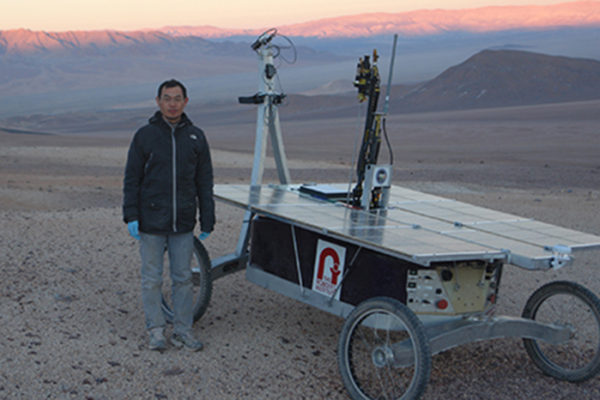Protein that delays cell division in bacteria may lead to the identification of new antibiotics
Bacteria adjust to wide fluctuations in food supply by controlling how big they get and how often they divide. Scientists at Washington University in St. Louis have just worked out the control system E. coli use to delay division so they can bulk up when food suddently becomes abundant. What can be delayed can also be stopped, so the control system may provide an opportunity to design a new class of antibiotics.
Successful dry run for the 2020 Mars Mission
In June, a rover named Zoe
set out into the Atacama Desert on the west coast of South America to test a suite of instruments intended for future missions to Mars under Mars-like conditions. One of the instruments aboard Zoe was a Raman spectrometer designed by a team led by Alian Wang of Washington University in St. Louis. A fragile lab instrument that was ruggidized to survive the desert, the Raman spectrometer is expected to fly on the 2020 Mars mission.
Social amoebae travel with a posse
Some social amoebae farm the bacteria they eat. Now a collaboration of scientists at Washington University in St.
Louis and Harvard University has taken a closer look at one lineage, or
clone, of D. discoideum farmer. This farmer carries not one but two strains of bacteria. One strain
is the “seed corn” for a crop of edible bacteria, and the other strain
is a weapon that produces defensive chemicals. The edible bacteria, the scientists found, evolved from the toxic one.
A chance to explore the hottest research topic in St. Louis
The International Society of Photosynthesis
Research, meeting this August in St. Louis, is offering an afternoon of
talks and demonstrations about the original “green” chemistry invented
by bacteria and plants and its relevance to our energy future. Intended for teachers, students and the public, “Photosynthesis in
our Lives” will take place from 3- 5 p.m. the afternoon of Sunday,
August 11, 2013 in the Parkview room at the Hyatt Regency at the Arch. RSVP to: http://parc.wustl.edu/outreachRSVP by August 7, 2013.
d’Avignon wins 2013 American Chemical Society Award
Washington University in St. Louis chemist D. André
d’Avignon, who manages the university’s high-resolution nuclear magnetic
resonance facility, has been named the winner of the 2013 Saint Louis
Award. The Saint Louis Award, administered by the St. Louis section of the American Chemical
Society, is given to an individual who has made outstanding
contributions to the profession of chemistry and demonstrated the potential
to further the advancement of the chemical profession.
How rice twice became a crop and twice became a weed — and what it means for the future
With the help of modern genetic technology and the
resources of the International Rice GeneBank, which contains more than
112,000 different types of rice, evolutionary biologist Kenneth Olsen has been able to look back in time at the double domestication of rice (in Asia and in Africa) and its double “de-domestication” to form two weedy strains. Olsen predicts the introduction of pesticide-resistant rice will drive ever faster adaptation in weedy rice.
The Swiss Army knife of salamanders
WUSTL biologist Alan Templeton and colleagues in Israel and Germany received $2 million to look at the shifting patterns of gene expression, called
the transcriptome, in two remarkably versatile species of fire salamander, one native to Israel and the other to Germany. The work may explain why this genus of salamanders is able to adapt to a wide variety of habitats when most salamander species live in one.
Scientists map the wiring of the biological clock
In the June 5 issue of Neuron, WUSTL biologist Erik Herzog and his
colleagues report the discovery of a crucial part of the biological
clock: the wiring that sets its accuracy to within a few minutes out of
the 1440 minutes per day. This wiring uses the neurotransmitter, GABA,
to connect the individual cells of the biological clock in a fast
network that changes strength with time of day.
Apollo 17 astronaut visits WUSTL for week of events related to lunar exploration
Harrison “Jack” Schmitt, a geologist and Apollo 17 astronaut, will be
visiting Washington University in St. Louis the week of May 20 for a
round of activities centered on lunar exploration, including a seminar about Schmitt’s geological exploration of the Moon’s Valley of Taurus-Littrow, an “exploration forum” and the review meeting of the Lunar Reconnaissance Orbiter Camera’s team, which is being hosted by WUSTL’s Brad Jolliff.
WUSTL alumna selected as a 2013 National Geographic Emerging Explorer
Bethany Ehlmann, who graduated from WUSTL in 2004 with a bachelor’s degree in earth and planetary science, has been selected as one of 17 Emerging Explorers by National Geographic. The Emerging Explorers Program recognizes
and supports uniquely gifted and inspiring adventurers, scientists and
innovators who are at the forefront of discovery, adventure and global
problem-solving while still early in their careers.
View More Stories


